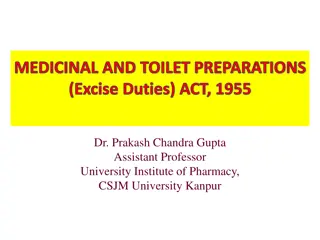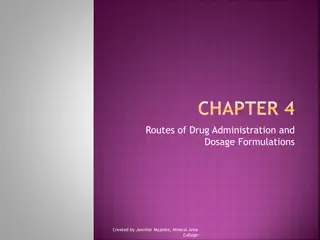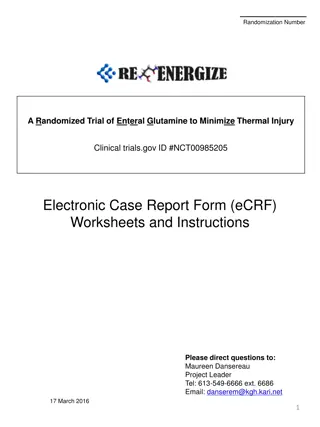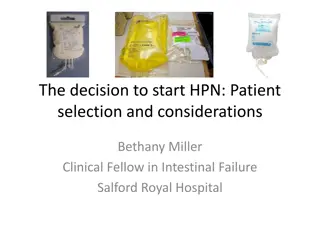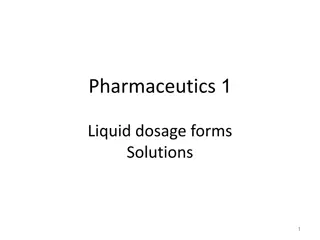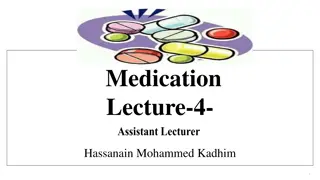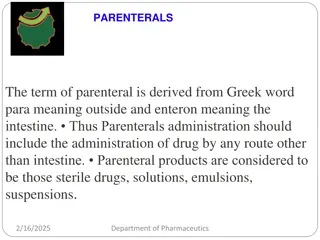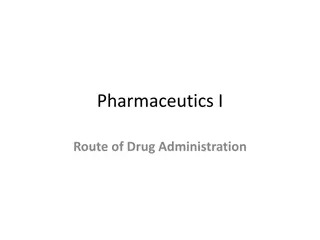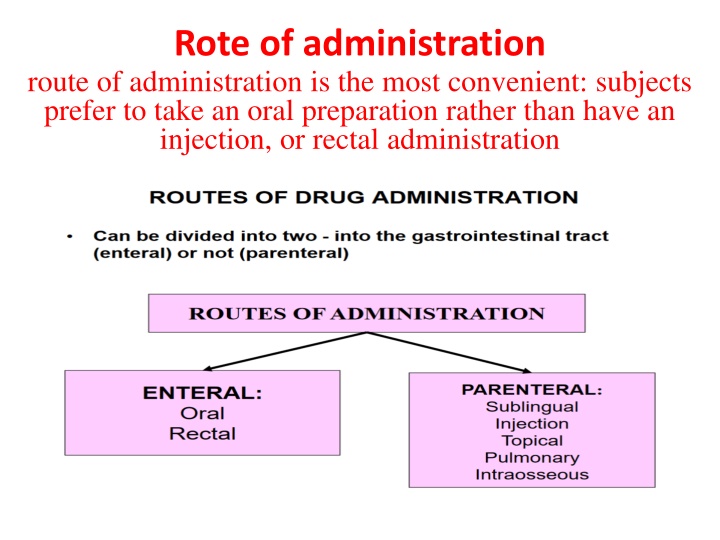
Routes of Drug Administration: Enteral vs Parenteral and Oral Preparations
Routes of drug administration play a crucial role in the efficacy and safety of medications. Enteral routes involve the gastrointestinal tract, while parenteral routes bypass it. Oral and rectal administrations are enteral, while sublingual, injection, and other parenteral methods offer alternative routes. Understanding these routes helps in determining drug effects and absorption rates. Oral administration is commonly preferred but may have slower onset compared to parenteral methods. Capsules and liquid preparations are often used to improve drug intake. Considerations like food interference and emesis risk also influence drug administration decisions.
Download Presentation

Please find below an Image/Link to download the presentation.
The content on the website is provided AS IS for your information and personal use only. It may not be sold, licensed, or shared on other websites without obtaining consent from the author. If you encounter any issues during the download, it is possible that the publisher has removed the file from their server.
You are allowed to download the files provided on this website for personal or commercial use, subject to the condition that they are used lawfully. All files are the property of their respective owners.
The content on the website is provided AS IS for your information and personal use only. It may not be sold, licensed, or shared on other websites without obtaining consent from the author.
E N D
Presentation Transcript
Rote of administration route of administration is the most convenient: subjects prefer to take an oral preparation rather than have an injection, or rectal administration
Routes of Drug Administration The routes of drug administration are described as enteral, which means into the gastrointestinal tract, or parenteral (not into the gastrointestinal tract) Routes that are enteral (into the gastrointestinal tract) are 1-oral and 2- rectal. Routes that are parenteral include 1-sublingual (under the tongue) 2- injection, which can be to a variety of sites e.g. into the vein (intravenous), into the muscle (intramuscular), under the skin (subcutaneous). 3- Other parenteral routes include topical, which is to a body surface, such as the skin, nose, eyes etc. 4- pulmonary, which is delivery to the lungs. These routes of drug administration are considered in sequence. administration used for a drug may also depend on whether a systemic (around the body) effect is required. Local administration is a way of trying to limit the effects of a drug to a local area. The route of
Oral administration more time to reverse the effects of a drug administered orally than when it is administered directly into a vein. commonly used route of administration. Oral administration usually gives systemic effects (around the body) rather than local effects of drugs. Thus, after oral administration, a drug ends up in the systemic circulation being widely distributed to tissues and organs, with the possibility of having a widespread effect. A disadvantage of oral administration can be the slow onset of action, as the drug has to be absorbed and taken to its required site of action before it can start to have an effect. In an emergency, drugs that are active after oral administration, may be given intravenously to speed up their onset of action. If the patient is vomiting, the drug may never reach the intestine to be absorbed. Thus, when the patient is vomiting, oral is not an appropriate route of drug administration. : is also the safest. For instance, we have Oral is the most
Hard gelatine Capsules contain a shell of gelatine, which is a tasteless natural substance. capsules contain the drug as solid, whereas soft gelatine capsules contain drug as an oily liquid. Capsules are often preferred to tablets as they disguise the taste. For instance, the antibiotic amoxycillin is given in capsule form to prevent its bad taste upsetting the subject. Children often have problems swallowing tablets or capsules. If swallowing is a problem, oral liquid preparations can be used. The gastrointestinal tract is designed to handle food and fluids not drugs. Drugs piggyback on the physiological processes to handle food. normally impact on food and fluids, can affect drug delivery. The absorption of some drugs is inhibited by forming complexes with components of the diet e.g. the tetracycline antibiotics form non-absorbable complexes with calcium (dairy products). Some drugs irritate the lining of the gastrointestinal tract to cause emesis (vomiting), and such drugs cannot be used orally e.g. some of the cytotoxic (cell killing) anti-cancer drugs. The processes that need to happen to get drug delivery from the gut into the circulation are given in Figure 1.3. Firstly, the drug has to be released from the dosage form (tablet or capsule). Secondly, the drug has to drug dissolution. After dissolution most drugs are absorbed by simple diffusion, although a few drugs are transported by physiological processes. The body has many membrane transporters. These are like being transported by a bus; they pick up drugs and take them to their destination across membranes. For instance, after the proteins have been broken down to amino acids, the amino acids are absorbed by active transport across the gut membrane. Drugs with similar structures to the natural substrates (substances) for these transporters can use these transporters. The most common method for drug absorption is diffusion. Also, the physiological processes that separate and/or dissolve; this is called
through (lipophilic). like. and absorbed by diffusion. In contrast, water soluble drugs (hydrophilic), which are not lipid soluble (lipophobic drugs), are not well absorbed after oral administration. Strong acids and strong bases (e.g. curare) are not absorbed. Thus, drugs are usually designed to be weak acids (e.g. aspirin) or weak bases (e.g. morphine), as these are more lipid soluble and readily diffuse through the gastrointestinal cells membranes. lipophilic at low pH (which occurs in the stomach) and are capable of being absorbed from the stomach. In contrast, weak bases are lipophilic at high pH (in the intestine), and are absorbed from the intestine. The stomach is acidic, with a pH of 1-3, compared with the small intestine, which has a pH in the range 5-8. Acidity is increased at night, and this may increase the absorption of some drugs. As the acidity in the stomach leads to the association of weak acids, some of these are absorbed from the stomach. However, the stomach is not designed for absorption, and most absorption occurs in the small intestine, which is designed for absorption with villi (projections) and microvilli giving a large surface area. Drugs will reach the small intestine more rapidly, if administered with water to a patient, whose stomach is empty of food. The small intestine is the primary site of drug absorption. The longer the drug remains in the small intestine (residence time), the greater the absorption of the drug from the intestine. lipid Philic means likes, whereas phobic means does not Drugs that are not water soluble (hydrophobic) are often lipophilic, the cell membranes, drugs must be lipid soluble Weak acids are
Some drugs are ineffective when administered by the oral route as they are destroyed by the acid in the stomach e.g. erythromycin. preparations are designed to prevent destruction by acid in the stomach, and this allows some of the drug, which would otherwise be destroyed by acid, to be effective after oral administration. The antibiotic erythromycin can be used in an enteric-coated preparation. an important term that is often used in association with the use of medicines is bioavailability. Bioavailability is the fraction of an ingested dose of a drug that gains access to the systemic circulation. To reach the circulation , drugs must penetrate the intestinal mucosa and avoid metabolism by the intestinal and liver enzymes. Drugs that reach the blood vessels of the gastrointestinal tract are carried in the blood supply directly to the liver by the portal vein. The liver is a major source of enzymes, and these enzymes are involved in the biochemical processes in the body. While, none of these enzymes have drugs as their natural substrates, they do metabolise drugs. metabolism. After oral administration, drugs cannot avoid being taken to the liver. Metabolism after absorption from the gut is known as First Pass Metabolism. If drugs undergo extensive first pass metabolism after oral administration, they are often administered by another route to avoid this inactivation e.g. sublingual, rectal .Whether drugs are administered orally or by other routes, they often end up in blood vessels, and, to reach their target site, have to then be absorbed from blood vessels. In addition to oral administration, routes of drug administration include sublingual, rectal, injection, topical, and pulmonary. Each of these routes has both advantages and disadvantages when compared to oral administration. Enteric-coated Indeed, many drugs are inactivated by
Sublingual Extensive first pass liver metabolism makes it difficult to administer some route. Sublingual(under the tough) administration can be used to avoid first pass liver metabolism. Drugs that are absorbed via the oral mucosa drain into the superior venae cavae to the heart and systemic circulation; they are not transported directly to the liver, and thus do not undergo first pass liver metabolism. systemic circulation, only part of the drug will pass through the liver with each circulation - the rest will go through other organs or tissues, which may not metabolise the drug to destroy it:The sublingual route of administration increases the bioavailability of drugs that are extensively metabolised by the liver. drugs by the oral Once in the
Rectal The rectum is at the end of the large intestine, and is about 15-20 cm long. Drugs are specially formulated for rectal administration, and the Solid Drug Formulations for Rectal Use are known as suppositories . Rectal administration avoids first pass liver metabolism. This is because, after insertion into the lower part of the rectum, absorption is into rectal veins and then into the general circulation. As the absorption is not into the portal vein, this avoids first pass metabolism. Another advantage of rectal administration is that the rectum has little enzymatic activity, and this route avoids upper gastro-intestinal acids and enzymes, which destroy many drugs. Rectal administration may be useful in the presence of upper gastrointestinal disease, which affects the absorption of the drug given via oral administration. Rectal administration can be useful when oral administration is not possible. For instance, in nausea and vomiting, or in subjects who have difficulty in swallowing, oral administration is not possible. Post-operative vomiting prevents oral administration, but drugs can be administered rectally to reach the circulation to be effective. In addition to being used to achieve systemic effects, the rectal route can also be used to give a local effect. For example, suppositories can be used in the treatment of haemorrhoids. The major disadvantage of rectal administration is that it is not popular with people.
Injection :There are mainly sites that drugs can be injected into, and the absorption will be different from each of these sites. The sites include intravenous (into the vein) intra-arterial (into the artery) intradermal (into the dermis layer of skin) subcutaneous (under subcutaneous tissue) intramuscular (into the muscle) intrathecal (into the cerebral spinal fluid) and epidural (into the epidural). the dermis, in the
: Injection into a vein (intravenous) relies on the skill of finding a Intravenous vein, getting a needle into the vein, and keeping the vein open during the injection. This is a skill that relies on practice at the patient s expense! One of the major advantages of the intravenous (i.v.) route is that it gives more immediacy and accuracy than other routes. Immediacy may be required in an emergency situation. In an emergency situation it may be necessary to sedate the subject quickly. After oral administration of a drug, it takes between 15-30 minutes to start to get any sedation. When the sedative midazolam is used intravenously, sedation occurs in 2-4 minutes. In a situation where a subject has intense pain, quick pain relief is required. Morphine is a potent analgesic (pain reliever). For quick pain relief, morphine is administered intravenously, and pain relief occurs in 10-15 minutes, whereas if morphine is administered orally, to takes 30 minutes to cause pain relief. After oral administration, in addition to the time lag for absorption, there may be a reduction in drug activity by liver metabolism, which gives a range of bioavailability, which is specific for each drug. administration avoids first pass liver metabolism, allows for a rapid effect, and the bioavailability is 100%. Because of the greater bioavailability after intravenous administration, a lower dose may be required after intravenous administration than oral administration. In contrast, intravenous
The intravenous route of administration can be used for drugs that are not active after oral administration e.g. gentamicin . The intravenous route of administration can often be used for drugs that irritate the intestinal mucosa, as blood vessel walls are quite insensitive. Many b-lactam antibiotics given intravenously One disadvantage of the intravenous route is that it is not suitable for all drugs. Drugs in oily vehicles or drugs that precipitate blood constituents or haemolyse red blood cells cannot be used intravenously. Another disadvantage of the intravenous route is that, with oral administration of the wrong drug or the wrong dose of a drug, there is an opportunity to remove the drug during absorption, and before it reaches the circulation, but this is not possible after intravenously administration. Thus, it is a disadvantage that the actions of an intravenously administered drug are often not easily reversed.
Intra-Arterial The injection (injection into an artery) is that it requires great care, and should only be done by experts. If you get it wrong, there will be blood everywhere! in the treatment of renal tumours or head/neck cancers, drugs can be injected into the renal artery or carotid artery, respectively. administration, the highest concentrations are localized and have their maximum effect locally. As the drug moves away from its site of injection, it is diluted in the circulation, and this reduces the toxicity of the drug. Another advantage of intra-arterial injection to the site of action is that it avoids first pass liver and lung metabolism. main disadvantage of intra-arterial After intra-arterial
Subcutaneous is injection of a drug under the skin. subcutaneous (s.c.) administration is that it avoids first pass liver metabolism, as the drug is released into the circulation, rather than specifically into the portal vein. From the subcutaneous area, absorption is often by diffusion. The drug is administered in a depot under the skin with absorption into plasma, and then to the circulation often sufficiently constant and slow to provide a sustained effect. administration can provide a slow release preparation for ongoing effects. Also, the rate of absorption after subcutaneous administration can be varied. For instance, in diabetics, soluble insulin with rapid absorption can be injected subcutaneously to mimic the rapid rise in blood insulin observed with a meal. Whereas an insoluble suspension of insulin can be used for the slow absorption required to give the low constant fasting level of insulin. The area affected by the subcutaneous administration of a drug can be limited by the injection of a vasoconstrictor (e.g. adrenaline) with the drug which will limits the transport of the drug away from the site of injection in the circulation. This method is used with local anaesthetics to keep the effect of the anaesthetic confined An advantage of Thus, subcutaneous to a local area.
Intramuscular: An advantage of intramuscular (i.m.) administration is that it avoids first pass liver metabolism, and it may be suitable for drugs that undergo extensive first pass liver metabolism. The intramuscular route is often suitable for drugs that are mucosal irritants or drugs subcutaneous injection. Drugs in aqueous solution are absorbed quite rapidly from muscle, but the rate of absorption will depend on the rate of blood flow at the injection site. If the blood flow is high, the rate of absorption will also be high. Blood flow to the legs is increased during jogging. If insulin is injected into the leg, rather that into the arm or abdominal wall, as recommended, it is absorbed quickly during jogging. With higher levels of insulin than expected, there is an increased take up of glucose into the tissues, which can cause an unwanted major drop in blood glucose leading to an episode of hypoglycaemia. Intramuscular is injection into the muscle. that are irritants after
Intrathecal Intrathecal is injection into the cerebral spinal fluid Intrathecal is a method for direct delivery of a drug to the central nervous system. with local anaesthetics to give spinal/regional anaesthesia, often prior to perform operations on low limbs. The opioid -receptors that mediate pain are in the spinal cord. Drugs that are administered to the cerebral spinal fluid are being delivered to this site of pain mediation. Thus, the intrathecal route of administration can opioid agonist morphine to give good pain relief. Intrathecal is used be used with the
Epidural An epidural is an injection into the epidural, which is the area above the dura mater, the layer before the cerebral spinal fluid. The best known example of epidural injections is when used with local anaesthetics during childbirth to prevent the pain associated with childbirth.
Topical :Topical administration is to the surface, and is used to give local effects. Topical administration avoids first pass metabolism. However, drugs that are absorbed into the circulation after local administration may then have systemic effects. The topical surface can be skin or mucous membranes, and these properties. Mucous membranes used for drug administration include those of the conjunctiva (eye), nasopharynx (nose), oropharynx (throat), vagina, urethra, and urinary bladder. from these mucous readily. Topical administration to the skin and selected mucous membranes are discussed below. have different Absorption occurs membranes
skin uses patches or ointments, which are applied to the skin. The outer layer of the skin (the epidermis) is a lipid barrier, and aqueous solutions will only be absorbed slowly. If necessary, absorption can be enhanced by suspending the drug in an oily substance. The epidermis is the main determinant of the rate of absorption from the skin, as the inner layer of the skin (the dermis) is freely permeable. Avoidance of first pass liver metabolism is a major advantage with administration. Thus, drugs that undergo extensive first pass liver metabolism can be used topically. Topical administration can be also be used to produce local effects and avoid systemic effects/side effect, when this is required. inflammatory sulfa drug is the best ex. For topical uses . However, they can be used safely in skin diseases with local application. administration to the skin provides the highest concentrations of many antibiotics that had been used in treating many burn and wound infections ..like gentamicin ointments , neomycin , fucidin , sulfa drug , tetracyclins . Topical administration of drugs to the skin usually The anti- Topical
Nasal Mucosa The nasal mucosa is highly porous and permeable to drugs. The nasal mucosa is highly vascularised. The nasal mucosa also has a relatively large surface area as a result of microvilli on the epithelial cells, and this aids absorption from the nasal mucosa. One disadvantage to the nasal route is that the drug may be rapidly removed by a runny nose. Thus, it is an unreliable route of administration in subjects with a cold or hay fever. Recently there has been an increased use of the intranasal route for the emergency/quick effect of drugs. For example, intranasal midazolam is used in the hospital setting to quickly stop an attack of status epilepticus. Most of the drugs that intranasally are those with effects on the nose. example,decongestants are administered into the nose, when it is congested in a cold. are commonly administered For
Eye When a drug is a liquid/drop form, it is placed on the conjunctiva, and the released drug dissolves in the tears, and following blinking, is distributed to the site of absorption, the cornea. Local effects usually require absorption of the drug through the cornea. Although eye drops are used for their local effects, absorption can lead to systemic effects as the drug is drained from the eye through the nasolacrimal canal. drainage is not subject to first pass liver metabolism, it can lead to systemic side effects. Drugs can also be administered to the eye in the form of an ointment. A small amount of ointment is put along the inside of the lower eyelid. Then, blinking will spread the ointment over the cornea, and the drug will be absorbed. This provides a more prolonged contact time with the cornea, absorption. With ointments, the application to the eye is less often than with drops. As this and more prolonged
Vaginal Suppository-shaped medications are available for vaginal administration. as pessaries, and are designed to obtain a local effect. An example of a drug used in a pessary is clotrimazole, an anti-fungal treatment of vaginal candidiasis (thrush). These are known drug for the
Pulmonary - Inhalation Drugs used for effects on the pulmonary system are often administered by inhalation to give the highest concentrations of the drug in the lung. The human respiratory tract has a considerable surface area, which should aid absorption, but most of this is deep in the alveolar region of the lung and it is difficult to deliver drugs deep into the lung. Inhalation is not actually a very good way of delivering drugs to the lung, as only about 10% of a drug that is inhaled actually goes to the lungs, the rest is swallowed, and may be absorbed from the gastrointestinal tract. With inhalation, predominant local effects are achieved in pulmonary diseases (e.g. bronchial asthma) by having the highest concentration of the drug in the lung. In asthma, metered-dose inhalers are used. . Another way to deliver drugs to the airways is to use a nebulisers. Nebulisers produce fine droplets in the air (aerosol), and are used to deliver large doses of drugs in an emergency. . After inhalation, when a drug is deep into the lung, access to the circulation is rapid because the lung has a large surface area. Thus, inhalation can also be used for widespread effects, including central effects.
Intraosseous Intraosseous is into the bone marrow. marrow is highly vascular, which means that drugs injected into the bone circulated. The needle injection is through the outer bone layer to the soft marrow interior. The injection is usually done just below knee. Intraosseous is not the first choice for drug administration. It is usually only done after two attempts at inserting a line to do an intravenous infusion have failed. intraosseous can be used include, a child 5 years or younger who is unconscious, unresponsive and in immediate danger of dying. The bone marrow are rapidly Examples of when



